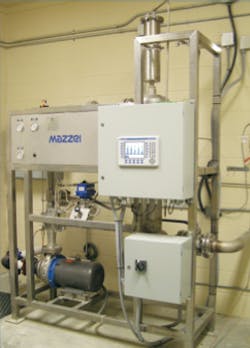A Clear Solution
Well Number 3 in eastern Angelina County, Texas, flows at 750 gpm and serves over 2,000 rural customers. The Four Way Special Utility District (SUD) faced aesthetic issues with hydrogen sulfide (H2S) and color due to the presence of tannic acids in the source water. While the presence of these contaminants is not uncommon, the conventional treatment methods being utilized—aeration and chlorine injection—were ineffective at controlling color, taste and odor and held the potential for exceeding regulated disinfection byproducts trihalomethanes (THMs) and haloacetic acids (HAA5) formation.
Solution
The utility district contacted Mike Walker, PE, of Goodwin-Lasiter Inc. in Lufkin, Texas, to evaluate the water concerns. Goodwin-Lasiter proposed ozone treatment as the solution and consulted with Jerry Clark of Clark Water Treatment in Nacogdoches, Texas—a manufacturer’s representative for Mazzei Injector Company LLC of Bakersfield, Calif.
Working together, the team submitted a design proposal that detailed solutions to the problems facing the utility district to the Texas Commission on Environmental Quality (TCEQ). After a few months of technical data exchange with the TCEQ, little progress had been made. Mazzei engineers traveled to Texas to support the consultant’s efforts to answer the commission’s questions and concerns about the benefits of ozone to meet the application needs and protect public health. The packaged ozone system design, incorporating the highly efficient Mazzei GDT ozone contacting system, was shown to allow tight control of the dissolved ozone levels to reduce color, taste and odor concerns while avoiding the formation of regulated disinfection byproducts, including THMs, HAA5 and bromate. Laboratory testing confirmed no excessive disinfection byproduct formation, supporting the process design presentation, resulting in the commission’s approval.
In addition to color, taste and odor control that ozone treatment provides, the process enhancement allowed for reduced chlorine dosage and discontinuation of the current high energy-demand air-stripping process. The ozone system installed included onsite oxygen and ozone generation, side-stream Mazzei GDT-3090 Ozone Transfer Skid and dissolved ozone measurement and control by a PLC PID loop.
Results
The ozone system, with the highly efficient GDT contacting element, is now in operation at Plant Number 3. The Four Way SUD follows stringent water monitoring and laboratory testing to meet TCEQ permitting requirements and is pleased with the results, which were slightly better than projected. The utility, its customers and the Texas Water Commission are very pleased that the negative well water quality parameters could be addressed so effectively by ozone treatment.
